The Influence of Caerulomycin A on the Intestinal Microbiota in SD Rats
Abstract
1. Introduction
2. Results
2.1. Sequencing Coverage of the Objects of Study
2.2. Dilution Curves of Microorganisms in Samples
2.3. Alpha Diversity of the Intestinal Flora
2.4. Beta Diversity of Intestinal Flora
2.5. LEfSe Analysis
2.6. The Influence of CRM A on the Structure of Intestinal Flora of SD Rats
2.7. The Influence of CRM A on the Structure of Intestinal Flora of SD Rats Relate to CRC
3. Discussion
4. Experimental Section
4.1. Chemicals and Reagents
4.2. Animals and Administration of CRM A
4.3. High-Throughput Sequencing of V3–V4 Region of Bacterial 16S rDNA Gene
4.3.1. Sample Collection
4.3.2. Genome DNA Extraction and Amplification
4.3.3. Library Construction
4.3.4. Bioinformatic Analysis
5. Conclusions
Supplementary Materials
Author Contributions
Funding
Acknowledgments
Conflicts of Interest
References
- Funk, A.; Divekar, P.V. Caerulomycin, a new antibiotic from Streptomyces caeruleus Baldacci. I. Production, isolation, assay, and biological properties. Can. J. Microbiol. 1959, 5, 317–321. [Google Scholar] [CrossRef] [PubMed]
- Fu, P.; Wang, S.; Hong, K.; Li, X.; Liu, P.; Wang, Y.; Zhu, W. Cytotoxic bipyridines from the marine-derived actinomycete Actinoalloteichus cyanogriseus WH1-2216-6. J. Nat. Prod. 2011, 74, 1751–1756. [Google Scholar] [CrossRef] [PubMed]
- Zhu, Y.; Fu, P.; Lin, Q.; Zhang, G.; Zhang, H.; Li, S.; Ju, J.; Zhu, W.; Zhang, C. Identification of caerulomycin A gene cluster implicates a tailoring amidohydrolase. Org. Lett. 2012, 14, 2666–2669. [Google Scholar] [CrossRef] [PubMed]
- Zhu, Y.; Zhang, Q.; Li, S.; Lin, Q.; Fu, P.; Zhang, G.; Zhang, H.; Shi, R.; Zhu, W.; Zhang, C. Insights into caerulomycin A biosynthesis: A two-component monooxygenase CrmH-catalyzed oxime formation. J. Am. Chem. Soc. 2013, 135, 18750–18753. [Google Scholar] [CrossRef]
- Zhu, Y.; Xu, J.; Mei, X.; Feng, Z.; Zhang, L.; Zhang, Q.; Zhang, G.; Zhu, W.; Liu, J.; Zhang, C. Biochemical and structural insights into the aminotransferase CrmG in caerulomycin biosynthesis. ACS Chem. Biol. 2016, 11, 943–952. [Google Scholar] [CrossRef]
- Zhu, Y.; Picard, M.È.; Zhang, Q.; Barma, J.; Després, X.M.; Mei, X.; Zhang, L.; Duvignaud, J.B.; Couture, M.; Zhu, W.; et al. Flavoenzyme CrmK-mediated substrate recycling in caerulomycin biosynthesis. Chem. Sci. 2016, 7, 4867–4874. [Google Scholar] [CrossRef]
- Kujur, W.; Gurram, R.K.; Haleem, N.; Maurya, S.K.; Agrewala, J.N. Caerulomycin A inhibits Th2 cell activity: A possible role in the management of asthma. Sci. Rep. 2015, 5, 15396. [Google Scholar] [CrossRef]
- Kujur, W.; Gurram, R.K.; Maurya, S.K.; Nadeem, S.; Chodisetti, S.B.; Khan, N.; Agrewala, J.N. Caerulomycin A suppresses the differentiation of naive T cells and alleviates the symptoms of experimental autoimmune encephalomyelitis. Autoimmunity 2017, 50, 317–328. [Google Scholar] [CrossRef]
- Mei, X.; Lan, M.; Cui, G.; Zhang, H.; Zhu, W. Caerulomycins from Actinoalloteichus cyanogriseus WH1-2216-6: Isolation, identification and cytotoxicity. Org. Chem. Front. 2019, 6, 3566–3574. [Google Scholar] [CrossRef]
- Bray, F.; Ferlay, J.; Soerjomataram, I.; Siegel, R.L.; Torre, L.A.; Jemal, A. Global cancer statistics 2018: GLOBOCAN estimates of incidence and mortality worldwide for 36 cancers in 185 countries. CA Cancer J. Clin. 2018, 68, 394–424. [Google Scholar] [CrossRef]
- Raskov, H.; Burcharth, J.; Pommergaard, H.C. Linking gut microbiota to colorectal cancer. J. Cancer 2017, 8, 3378–3395. [Google Scholar] [CrossRef] [PubMed]
- Temraz, S.; Nassar, F.; Nasr, R.; Charafeddine, M.; Mukherji, D.; Shamseddine, A. Gut microbiome: A promising biomarker for immunotherapy in colorectal cancer. Int. J. Mol. Sci. 2019, 20, 4155. [Google Scholar] [CrossRef] [PubMed]
- Lin, C.; Cai, X.; Zhang, J.; Wang, W.; Sheng, Q.; Hua, H.; Zhou, X. Role of gut microbiota in the development and treatment of colorectal cancer. Digestion 2019, 100, 72–78. [Google Scholar] [CrossRef]
- Wieczorska, K.; Stolarek, M.; Stec, R. The role of the gut microbiome in colorectal cancer: Where are we? where are we going? Clin. Colorectal Cancer 2020, 19, 5–12. [Google Scholar] [CrossRef]
- Bevins, C.L.; Salzman, N.H. Paneth cells, antimicrobial peptides and maintenance of intestinal homeostasis. Nat. Rev. Microbiol. 2011, 9, 356–368. [Google Scholar] [CrossRef]
- Jai, H.J.; Wang, C.; Wang, Y.; Liu, P.P.; Zhu, W.M. Fermentation optimization for the production of caerulomycin A from marine-derived Actinoalloteichus cyanogriseus WH1-2216-6. Chin. J. Mar. Drugs 2014, 33, 9–15. [Google Scholar] [CrossRef]
- Tilg, H.; Adolph, T.E.; Gerner, R.R.; Moschen, A.R. The Intestinal Microbiota in Colorectal Cancer. Cancer Cell 2018, 33, 954–964. [Google Scholar] [CrossRef] [PubMed]
- Gagniere, J.; Raisch, J.; Veziant, J.; Barnich, N.; Bonnet, R.; Buc, E.; Bringer, M.A.; Pezet, D.; Bonnet, M. Gut microbiota imbalance and colorectal cancer. World J. Gastroenterol. 2016, 22, 501–518. [Google Scholar] [CrossRef]
- Lucas, C.; Barnich, N.; Nguyen, H.T.T. Microbiota, Inflammation and Colorectal Cancer. Int. J. Mol. Sci. 2017, 18, 1310. [Google Scholar] [CrossRef]
- Villeger, R.; Lopes, A.; Veziant, J.; Gagniere, J.; Barnich, N.; Billard, E.; Boucher, D.; Bonnet, M. Microbial markers in colorectal cancer detection and/or prognosis. World J. Gastroenterol. 2018, 24, 2327–2347. [Google Scholar] [CrossRef]
- Park, C.H.; Eun, C.S.; Han, D.S. Intestinal microbiota, chronic inflammation, and colorectal cancer. Intest. Res. 2018, 16, 338–345. [Google Scholar] [CrossRef] [PubMed]
- Hibberd, A.A.; Lyra, A.; Ouwehand, A.C.; Rolny, P.; Lindegren, H.; Cedgard, L.; Wettergren, Y. Intestinal microbiota is altered in patients with colon cancer and modified by probiotic intervention. BMJ Open Gastroenterol. 2017, 4, e000145. [Google Scholar] [CrossRef] [PubMed]
- Abed, J.; Emgard, J.E.; Zamir, G.; Faroja, M.; Almogy, G.; Grenov, A.; Sol, A.; Naor, R.; Pikarsky, E.; Atlan, K.A.; et al. Fap2 Mediates Fusobacterium nucleatum Colorectal Adenocarcinoma Enrichment by Binding to Tumor-Expressed Gal-GalNAc. Cell Host Microbe 2016, 20, 215–225. [Google Scholar] [CrossRef] [PubMed]
- Yu, T.; Guo, F.; Yu, Y.; Sun, T.; Ma, D.; Han, J.; Qian, Y.; Kryczek, I.; Sun, D.; Nagarsheth, N.; et al. Fusobacterium nucleatum Promotes Chemoresistance to Colorectal Cancer by Modulating Autophagy. Cell 2017, 170, 548–563.e16. [Google Scholar] [CrossRef]
- Gur, C.; Ibrahim, Y.; Isaacson, B.; Yamin, R.; Abed, J.; Gamliel, M.; Enk, J.; Bar-On, Y.; Stanietsky-Kaynan, N.; Coppenhagen-Glazer, S.; et al. Binding of the Fap2 protein of Fusobacterium nucleatum to human inhibitory receptor TIGIT protects tumors from immune cell attack. Immunity 2015, 42, 344–355. [Google Scholar] [CrossRef]
- Boleij, A.; Hechenbleikner, E.M.; Goodwin, A.C.; Badani, R.; Stein, E.M.; Lazarev, M.G.; Ellis, B.; Carroll, K.C.; Albesiano, E.; Wick, E.C.; et al. The Bacteroides fragilis toxin gene is prevalent in the colon mucosa of colorectal cancer patients. Clin. Infect. Dis. 2015, 60, 208–215. [Google Scholar] [CrossRef]
- Arthur, J.C.; Perez-Chanona, E.; Mühlbauer, M.; Tomkovich, S.; Uronis, J.M.; Fan, T.-J.; Campbell, B.J.; Abujamel, T.; Dogan, B.; Rogers, A.B.; et al. Intestinal Inflammation Targets Cancer-Inducing Activity of the Microbiota. Science 2012, 338, 120–123. [Google Scholar] [CrossRef]
- Zackular, J.P.; Rogers, M.A.; Ruffin, M.T.; Schloss, P.D. The human gut microbiome as a screening tool for colorectal cancer. Cancer Prev. Res. 2014, 7, 1112–1121. [Google Scholar] [CrossRef] [PubMed]
- Okada, T.; Fukuda, S.; Hase, K.; Nishiumi, S.; Izumi, Y.; Yoshida, M.; Hagiwara, T.; Kawashima, R.; Yamazaki, M.; Oshio, T.; et al. Microbiota-derived lactate accelerates colon epithelial cell turnover in starvation-refed mice. Nat. Commun. 2013, 4, 1654. [Google Scholar] [CrossRef]
- Osterlund, P.; Ruotsalainen, T.; Korpela, R.; Saxelin, M.; Ollus, A.; Valta, P.; Kouri, M.; Elomaa, I.; Joensuu, H. Lactobacillus supplementation for diarrhoea related to chemotherapy of colorectal cancer: A randomised study. Br. J. Cancer 2007, 97, 1028–1034. [Google Scholar] [CrossRef]
- Hendler, R.; Zhang, Y. Probiotics in the Treatment of Colorectal Cancer. Medicines 2018, 5, 101. [Google Scholar] [CrossRef] [PubMed]
- Chitapanarux, I.; Tungkasamit, T.; Petsuksiri, J.; Kannarunimit, D.; Katanyoo, K.; Chakkabat, C.; Setakornnukul, J.; Wongsrita, S.; Jirawatwarakul, N.; Lertbusayanukul, C.; et al. Randomized control trial of benzydamine HCl versus sodium bicarbonate for prophylaxis of concurrent chemoradiation-induced oral mucositis. Support Care Cancer 2018, 26, 879–886. [Google Scholar] [CrossRef]
- Bolger, A.M.; Lohse, M.; Usadel, B. Trimmomatic: A flexible trimmer for Illumina sequence data. Bioinformatics 2014, 30, 2114–2120. [Google Scholar] [CrossRef] [PubMed]
- Reyon, D.; Tsai, S.Q.; Khayter, C.; Foden, J.A.; Sander, J.D.; Joung, J.K. FLASH assembly of TALENs for high-throughput genome editing. Nat. Biotechnol. 2012, 30, 460–465. [Google Scholar] [CrossRef] [PubMed]
- Caporaso, J.G.; Kuczynski, J.; Stombaugh, J.; Bittinger, K.; Bushman, F.D.; Costello, E.K.; Fierer, N.; Pena, A.G.; Goodrich, J.K.; Gordon, J.I.; et al. QIIME allows analysis of high-throughput community sequencing data. Nat. Methods 2010, 7, 335–336. [Google Scholar] [CrossRef]
- Edgar, R.C. UPARSE: Highly accurate OTU sequences from microbial amplicon reads. Nat. Methods 2013, 10, 996–998. [Google Scholar] [CrossRef]
- Wang, Q.; Garrity, G.M.; Tiedje, J.M.; Cole, J.R. Naive Bayesian classifier for rapid assignment of rRNA sequences into the new bacterial taxonomy. Appl. Environ. Microbiol. 2007, 73, 5261–5267. [Google Scholar] [CrossRef]
- Lozupone, C.; Knight, R. UniFrac: A New Phylogenetic Method for Comparing Microbial Communities. Appl. Environ. Microbiol. 2005, 71, 8228–8235. [Google Scholar] [CrossRef]
- Segata, N.; Izard, J.; Waldron, L.; Gevers, D.; Miropolsky, L.; Garrett, W.S.; Huttenhower, C. Metagenomic biomarker discovery and explanation. Genome Biol. 2011, 12, R60. [Google Scholar] [CrossRef]
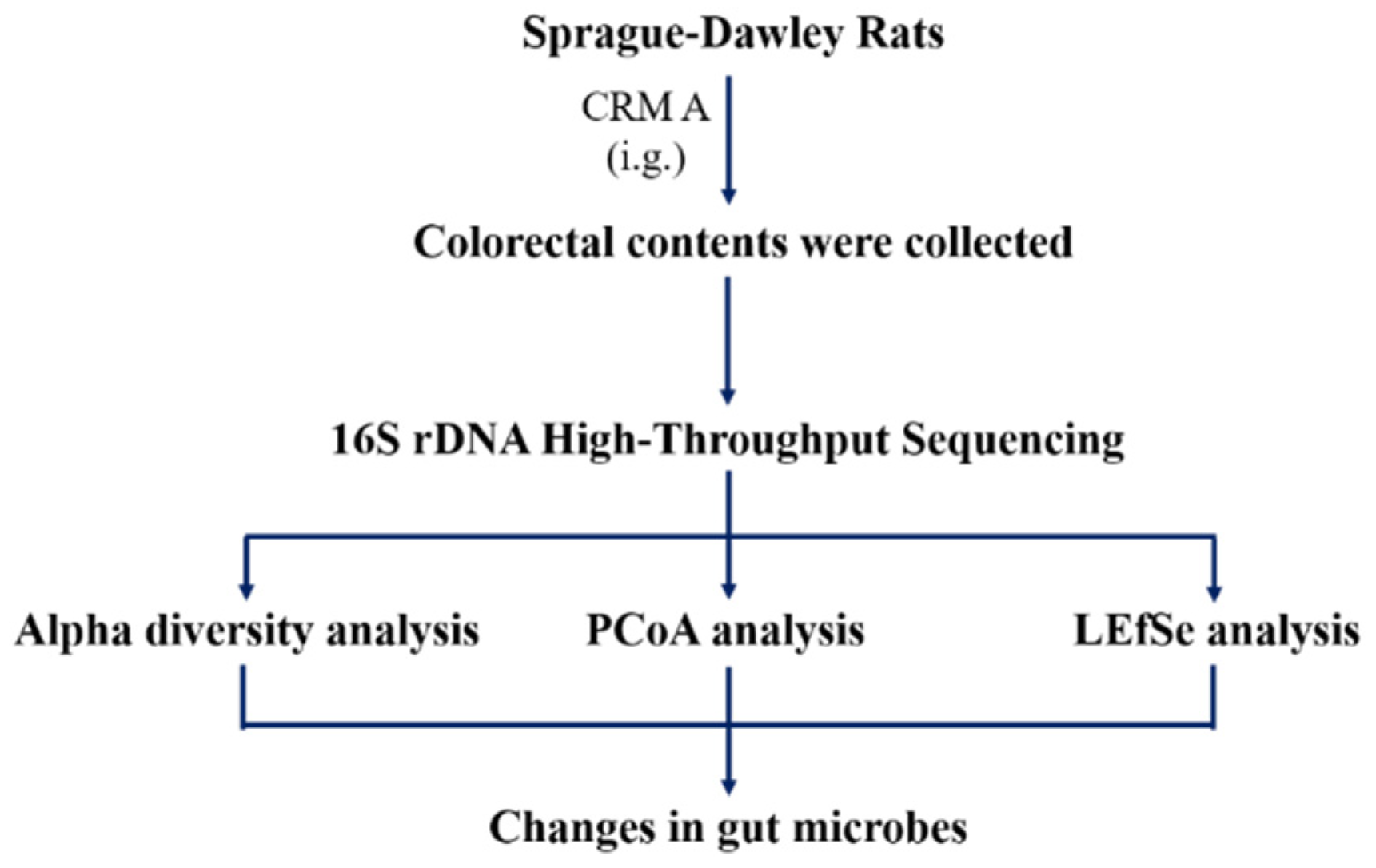
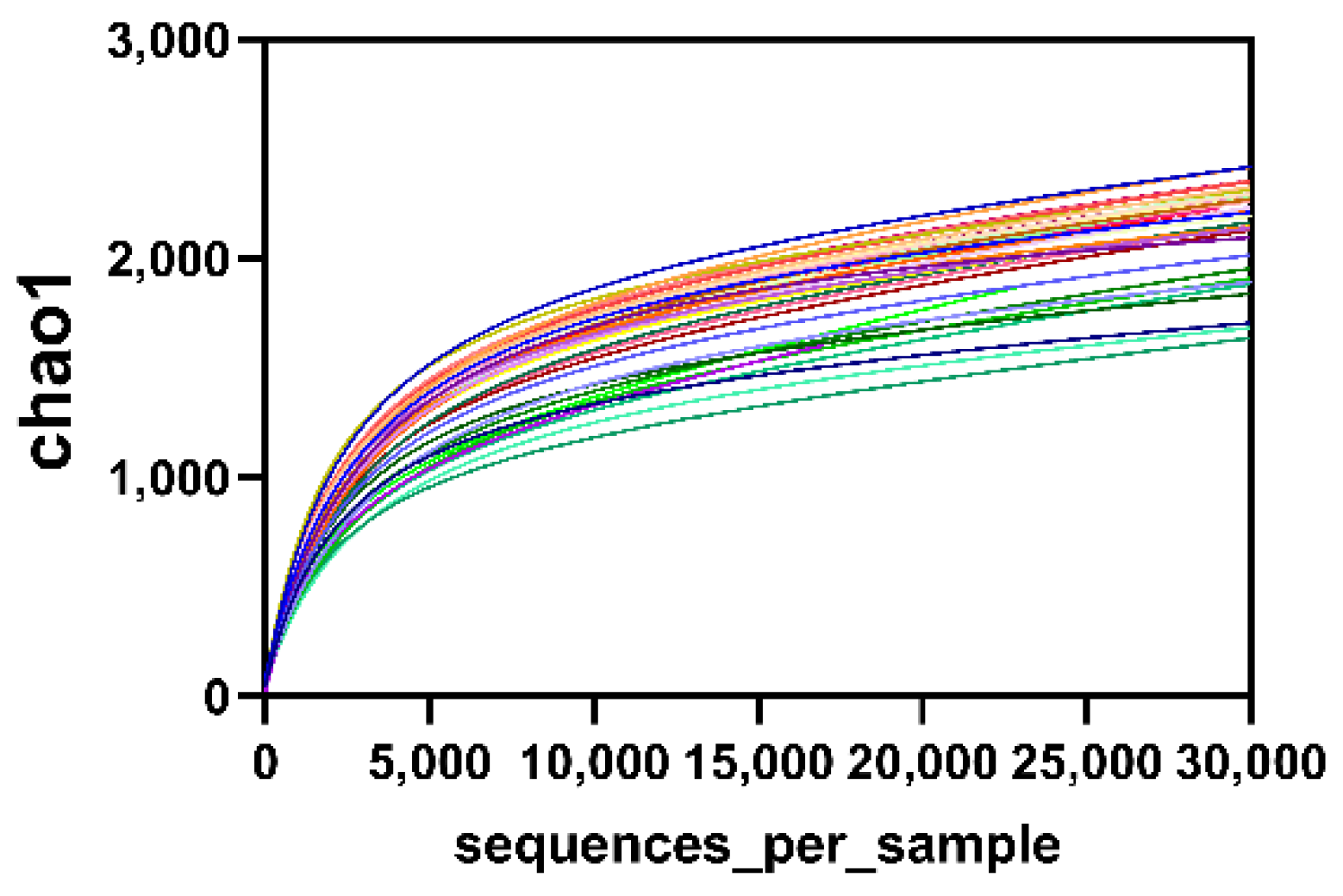
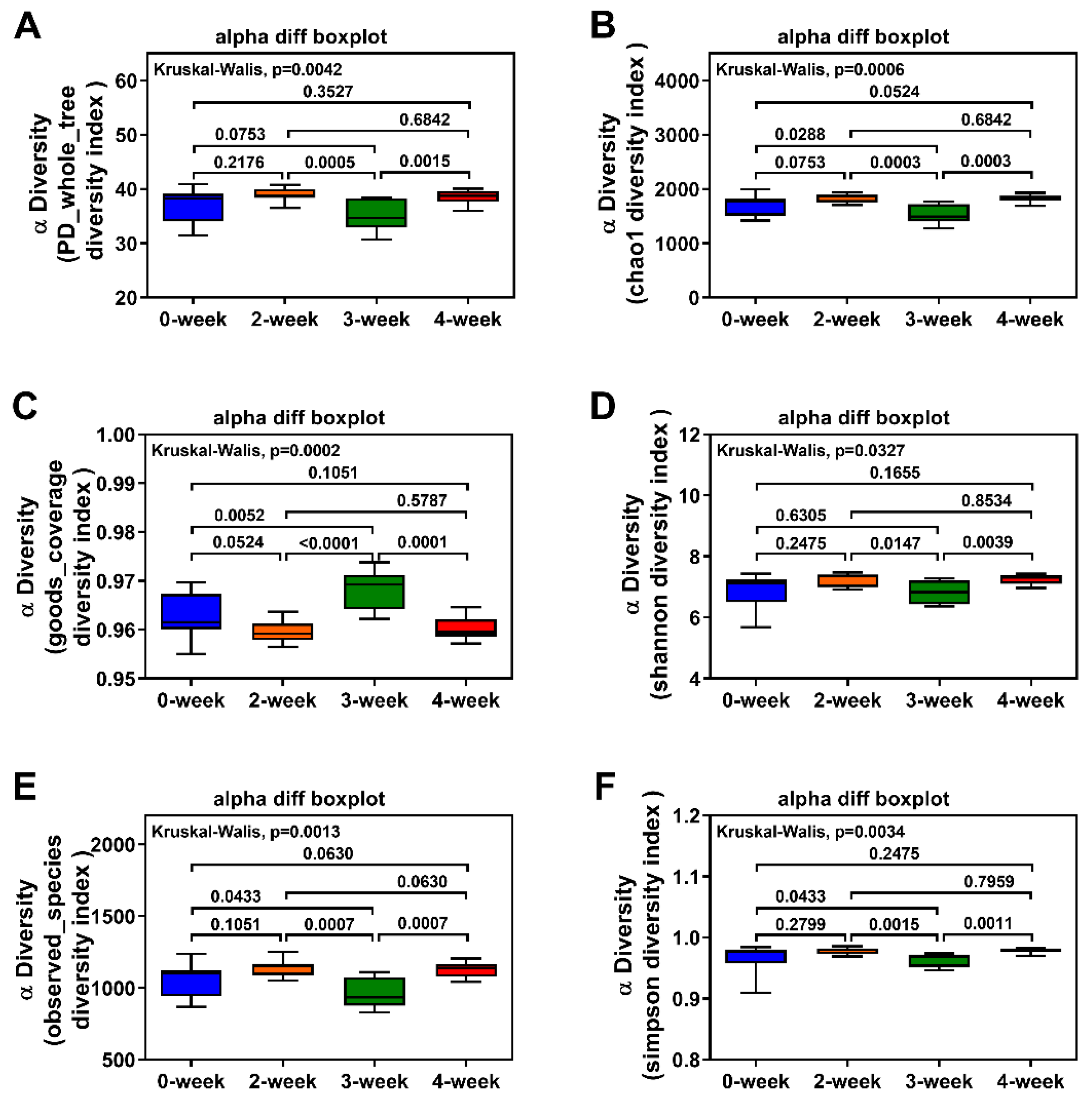
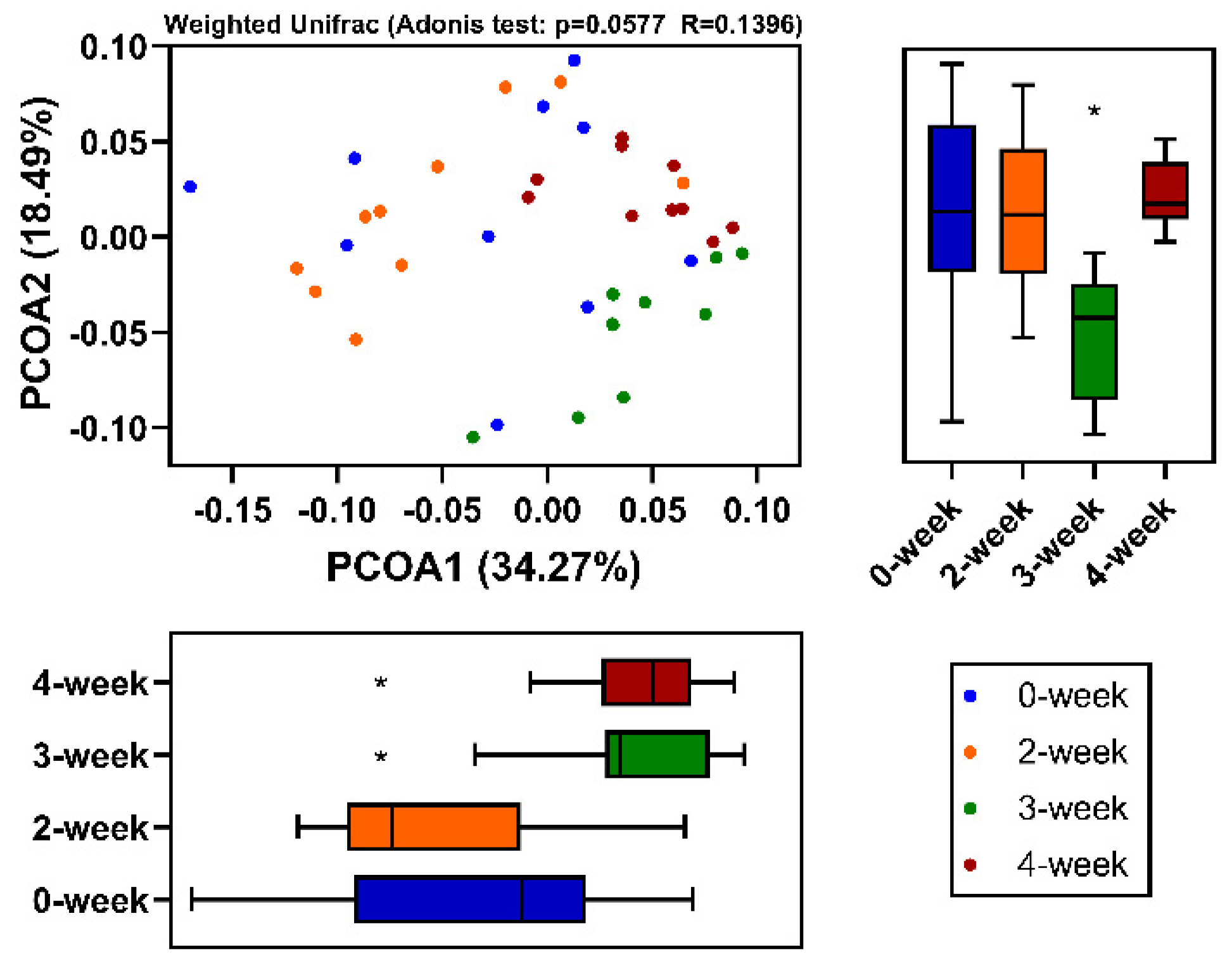
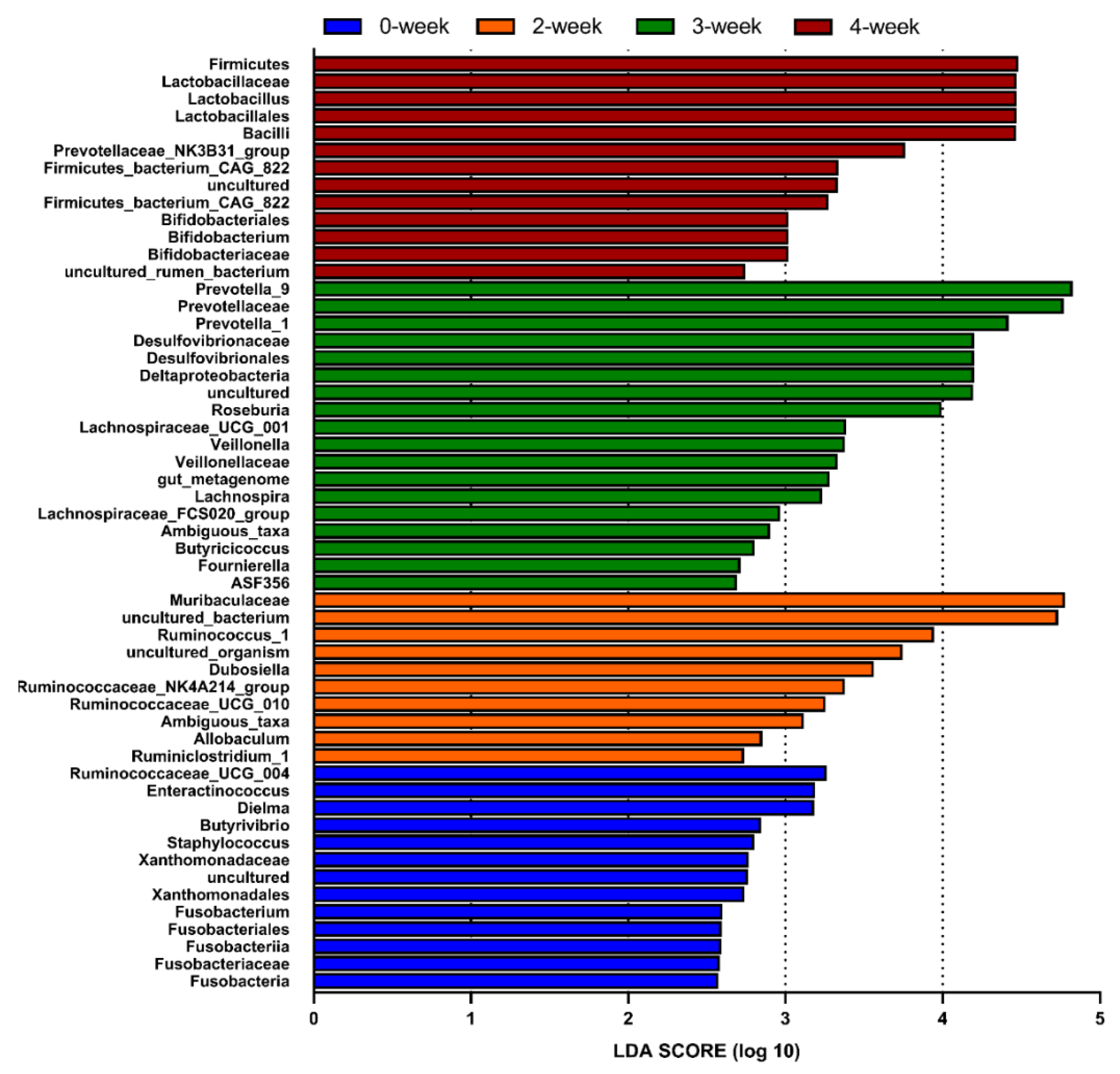

| Taxon | 0-Week | 2-Week | 3-Week | 4-Week | Test-Statistic | p |
|---|---|---|---|---|---|---|
| Bacteroidetes | 62.1640 | 64.8152 | 59.5583 | 56.0251 | 3.3468 | 0.3412 |
| Firmicutes | 30.4237 | 30.1758 | 32.7556 | 38.8031 | 8.7585 | 0.0327 |
| Proteobacteria | 6.1519 | 3.7595 | 5.9350 | 2.8594 | 14.3512 | 0.0025 |
| Epsilonbacteraeota | 0.3358 | 0.2810 | 0.8496 | 0.8568 | 11.5744 | 0.0090 |
| Actinobacteria | 0.2681 | 0.3877 | 0.2443 | 0.3394 | 3.2626 | 0.3529 |
| Tenericutes | 0.3531 | 0.2191 | 0.2320 | 0.8129 | 11.2410 | 0.0105 |
| Total | 99.6966 | 99.6383 | 99.5748 | 99.6966 |
| Taxon | 0-Week | 2-Week | 3-Week | 4-Week | Test-Statistic | p |
|---|---|---|---|---|---|---|
| Prevotellaceae_UCG-003 | 10.2875 | 12.4177 | 8.4831 | 7.9037 | 5.4219 | 0.1434 |
| Prevotella_9 | 8.6755 | 7.7603 | 19.1136 | 11.7028 | 17.2463 | 0.0006 |
| Alloprevotella | 6.1404 | 5.0177 | 1.8974 | 2.6281 | 21.7162 | 0.0001 |
| Lactobacillus | 4.0124 | 1.6408 | 4.3597 | 7.0909 | 17.1249 | 0.0007 |
| Lachnospiraceae_NK4A136_group | 3.7926 | 3.9663 | 3.3480 | 5.4652 | 7.4381 | 0.0592 |
| Escherichia-Shigella | 3.2305 | 0.1045 | 0.3733 | 0.0670 | 8.8984 | 0.0307 |
| Bacteroides | 3.1080 | 2.1532 | 2.0444 | 1.6718 | 1.9222 | 0.5887 |
| Prevotella_1 | 2.7996 | 3.1260 | 6.1425 | 2.0343 | 14.4278 | 0.0024 |
| Ruminococcus_1 | 1.8239 | 2.5618 | 1.0139 | 1.9687 | 16.5849 | 0.0009 |
| Ruminococcaceae_UCG-014 | 1.8095 | 1.7453 | 1.6589 | 2.5085 | 4.9301 | 0.1770 |
| Total | 45.6799 | 40.4936 | 48.4348 | 43.0410 |
| Taxon | 0-Week | 2-Week | 3-Week | 4-Week | Test-Statistic | p |
|---|---|---|---|---|---|---|
| Bacteroidetes | 62.1640 | 64.8152 | 59.5583 | 56.0251 | 3.3468 | 0.3412 |
| Firmicutes | 30.4237 | 30.1758 | 32.7556 | 38.8031 | 8.7585 | 0.0327 |
| Proteobacteria | 6.1519 | 3.7595 | 5.9350 | 2.8594 | 14.3512 | 0.0025 |
| Fusobacteria | 0.0173 | 0.0050 | 0.0000 | 0.0029 | 9.4593 | 0.0238 |
| Taxon | 0-Week | 2-Week | 3-Week | 4-Week | Test-Statistic | p |
|---|---|---|---|---|---|---|
| Bifidobacteriaceae | 0.0418 | 0.1521 | 0.1319 | 0.2630 | 12.4351 | 0.0060 |
| Lactobacillaceae | 4.0124 | 1.6408 | 4.3597 | 7.0909 | 17.1249 | 0.0007 |
| Lachnospiraceae | 11.9536 | 11.7223 | 14.5629 | 16.2139 | 5.8054 | 0.1215 |
| Taxon | 0-Week | 2-Week | 3-Week | 4-Week | Test-Statistic | p |
|---|---|---|---|---|---|---|
| Bacteroides | 3.1080 | 2.1532 | 2.0444 | 1.6718 | 0.7965 | 0.5040 |
| Fusobacterium | 0.0173 | 0.0050 | 0.0000 | 0.0029 | 4.3240 | 0.0106 |
| Enterococcus | 0.0036 | 0.0022 | 0.0050 | 0.0007 | 0.9375 | 0.4326 |
| Escherichia-Shigella | 3.2305 | 0.1045 | 0.3733 | 0.0670 | 1.4653 | 0.2403 |
| Klebsiella | 0.0007 | 0.0036 | 0.0036 | 0.0000 | 1.5660 | 0.2145 |
| Streptococcus | 0.0072 | 0.0000 | 0.0014 | 0.0036 | 10.5590 | 0.0144 |
| Ruminococcus_2 | 0.0454 | 0.0576 | 0.0295 | 0.0418 | 3.7683 | 0.2876 |
| Peptococcus | 0.0504 | 0.0447 | 0.0447 | 0.0368 | 0.6246 | 0.8908 |
| Bifidobacterium | 0.0418 | 0.1521 | 0.1319 | 0.2630 | 2.8433 | 0.0513 |
| Lactobacillus | 4.0124 | 1.6408 | 4.3597 | 7.0909 | 17.1249 | 0.0007 |
| Faecalibacterium | 0.0000 | 0.0036 | 0.0007 | 0.0014 | 2.4000 | 0.0838 |
| Blautia | 0.1175 | 0.1809 | 0.1081 | 0.1571 | 0.5695 | 0.6387 |
| Oscillibacter | 0.4749 | 0.4828 | 0.5693 | 0.4518 | 2.1415 | 0.5436 |
| Clostridium | 0.0699 | 0.0973 | 0.2212 | 0.2529 | 5.8599 | 0.1186 |
© 2020 by the authors. Licensee MDPI, Basel, Switzerland. This article is an open access article distributed under the terms and conditions of the Creative Commons Attribution (CC BY) license (http://creativecommons.org/licenses/by/4.0/).
Share and Cite
Zhang, H.; Lan, M.; Cui, G.; Zhu, W. The Influence of Caerulomycin A on the Intestinal Microbiota in SD Rats. Mar. Drugs 2020, 18, 277. https://doi.org/10.3390/md18050277
Zhang H, Lan M, Cui G, Zhu W. The Influence of Caerulomycin A on the Intestinal Microbiota in SD Rats. Marine Drugs. 2020; 18(5):277. https://doi.org/10.3390/md18050277
Chicago/Turabian StyleZhang, Hongwei, Mengmeng Lan, Guodong Cui, and Weiming Zhu. 2020. "The Influence of Caerulomycin A on the Intestinal Microbiota in SD Rats" Marine Drugs 18, no. 5: 277. https://doi.org/10.3390/md18050277
APA StyleZhang, H., Lan, M., Cui, G., & Zhu, W. (2020). The Influence of Caerulomycin A on the Intestinal Microbiota in SD Rats. Marine Drugs, 18(5), 277. https://doi.org/10.3390/md18050277





